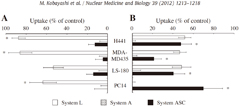- Home
- Highlights
- Revealing how amino acids move around tumor cells
Highlights
Revealing how amino acids move around tumor cells
A Japanese research team have clarified the gene transport mechanisms for amino acid-based radiotracers used in tumor scans.
Amino acid transporter genes are highly expressed in tumor cells, meaning tumors attract large amounts of amino acids. Neutral amino acids - such as S-methyl-C-labeled L-methionine (C-L-MET) and D-methionine (D-MET) - can therefore be used with radioactive carbon-11 as radiotracers searching for tumors in positron emission tomography (PET) scans. However, C- L-MET has limitations because it reacts to enzymatic metabolism and gathers in healthy tissues.
The research team led by Keiichi Kawai at Kanazawa University’s School of Medical Sciences measured gene expression involved in C-L-MET and D-MET transportation within tumor cells. There are three gene transport systems for amino acids in the body: L, A, and alanine-serine-cysteine (ASC). C-L-MET is known to be transported by system L, but the transport mechanism for D-MET is unclear.
Kawai’s team took cells from human-derived lung cancer tumors (labelled H441 and PC14), and from breast and colon cancers, and injected them into mice. C-L-MET and D-MET amino acids were then injected and traced. Normal mice were also injected with C- L-MET and D-MET to check for metabolic stability, and accumulation in healthy tissues.
System L dominated for C- L-MET as anticipated, and was also prominent for D-MET in breast, colon, and lung cancer H441. However D-MET preferred system ASC for lung cancer PC14.
D-MET was metabolically stable, with only 3% taken up by proteins to gather in healthy tissues, compared with 25 – 40% of C-L-MET. The researchers conclude D-MET amino acids are potentially more versatile across the body as radiotracers.
Publication and Affiliation
Masato Kobayashi1,2, Fumiya Hashimoto1, Kazuyo Ohe1, Takahiro Nadamura1, Kodai Nishi1, Naoto Shikano3, Ryuichi Nishii4, Tatsuya Higashi5, Hidehiko Okazawa2, & Keiichi Kawai1,2,*. Transport mechanism of 11C-labeled L- and D-methionine in human-derived tumor cells. Elsevier: Nuclear Medicine and Biology 39, 1213-1218 (2012).
Link
1. School of Health Sciences, College of Medical, Pharmaceutical and Health Sciences, Kanazawa University, Kanazawa 920-0942, Japan
2. Biomedical Imaging Research Center, University of Fukui, Fukui 910-1193, Japan
3. Department of Radiological Sciences, Ibaraki Prefectural University of Health Sciences, Ibaraki 300-0331, Japan
4. Department of Radiology, School of Medicine, Miyazaki University, Miyazaki 889-2192, Japan
5. Division of PET Imaging, Shiga Medical Center Research Institute, Shiga 524-8524, Japan
*corresponding author, e-mail address: kei@mhs.mp.kanazawa-u.ac.jp
ID: 201212B011

